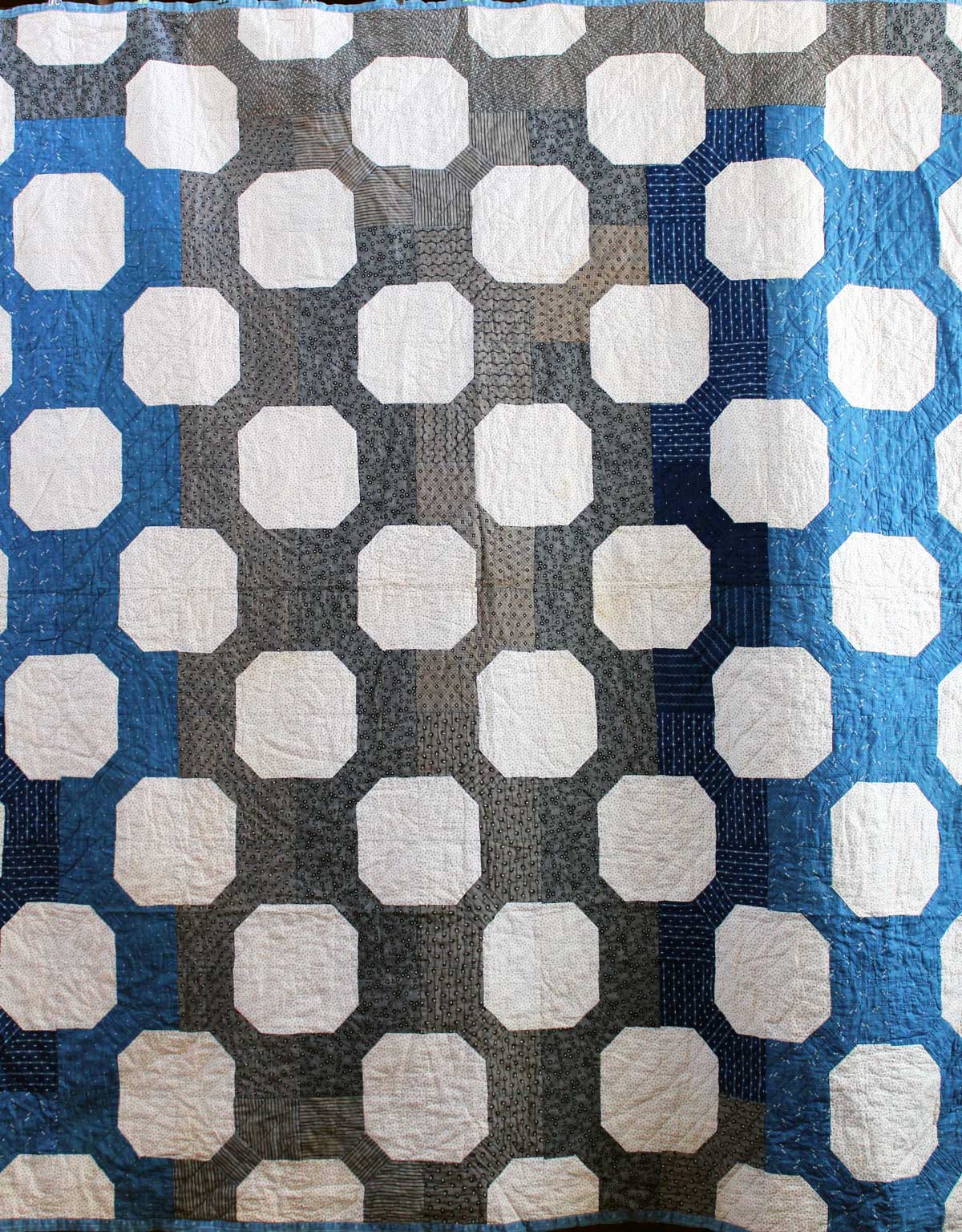Bow Tie or Neck Tie quilts – when fashion meets quilting
March 2025
Covering Quilts
Bow Tie or Neck Tie quilts – when fashion meets quilting
by Sandra Starley
While many quilt pattern names from the 1800s are cloaked in myth, mystery, and marketing, the Bow Tie pattern is clearly a representational block depicting male neckwear, aka neck ties. “The bow tie first entered the scene as a new style of necktie in the beginning of the 19th century. By the mid 1880s, the bow tie had become a staple in the fashion-conscious man’s wardrobe” (thebowtie.com). Not surprisingly, the Bow Tie quilt pattern also dates from the 1880s. It was first published as Necktie in the Ladies Art Co. catalog of block patterns in 1895. Other names for this traditional block include Colonial Bow Tie, Peekhole, and True Lover’s Knot. As befits the block’s masculine inspiration, this pattern is the perfect design for a man’s or boy’s quilt and truly is the quintessential manly quilt pattern.
In researching this pattern, I found a number of references to its use in helping slaves navigate the Underground Railroad as part of a group of blocks said to contain a secret “quilt code.” Of course, the Underground Railroad existed before the Civil War and helped many break away from slavery but not through clues on quilts. Slaves fleeing for their lives did not need a Bow Tie quilt block to tell them to discard their old clothing and not look like slaves. Nor did they need a North Star block to know to head North to safety. While quilts were used for warmth or protection, there is “no historical evidence of quilts being used as signals, codes, or maps. The tale of quilts and the Underground Railroad makes a good story, but not good quilt history” (Barbara Brackman quoted at antiquequiltdating.com/Fact_Sheet_on_the_Quilt_Code.html. For more information, see her book “Facts & Fabrications: Unraveling the History of Quilts & Slavery,” 2006).
There are several ways to construct a Bow Tie block and a method for every skill level from beginner to advanced quilters. The original construction method involves inset seams and precision sewing. This method, which is more difficult, is often accomplished by hand sewing, which is better suited to the technique. In 1931, quilt designer Ruby McKim noted her Necktie “block is about as simple to make as a bowknot is to tie.” Since a Google search yields “14 steps to tie a bow tie,” I think that indicates that she considered it quite difficult to sew.
At about the same time (early 1930s), a new quick sew method appeared on the quilting scene. This fast and easy method uses four squares with small triangles added on the two background squares to complete the center knot. Since stodgy traditional quilters often scoff at modern quilters for looking for easy tricks, it is nice to see that quilting shortcuts have been around for a long time.
Single Bow Tie blocks can be combined to create additional interesting secondary patterns. Joining 4 blocks together in a diamond shape creates the pattern known as Magic Circle or Dumbell Block. With sashing added between the single ties, more blocks are created including Carrie’s Choice (Clara Stone, 1906) and Midget Necktie (Kansas City Star, 1937). The Bow Tie pattern continues to be very popular and online tutorials, quilt-alongs, block swaps, and classes abound for both traditional and Modern Bow Tie quilts.
On a collecting note: there are many vintage and antique Bow Tie blocks and quilts currently available for reasonable prices, so it might be time to “tie one on” and start your own Bow Tie collection

C. 1890 Amish Bow Tie quilt from the Donna Starley collection. (Image courtesy of the author)
Sandra Starley is nationally certified quilt appraiser, quilt historian, and avid antique quilt collector. She travels throughout the U.S. presenting talks on antique quilt history, fabric dating classes and trunk shows as well as quilting classes. Learn more at utahquiltappraiser.blogspot.com. Send your comments and quilt questions to SandraStarley@outlook.com
Pressing matters: Part 2
April 2022Covering QuiltsPressing matters: Part 2by Sandra Starley Last month I wrote about the importance of properly pressing quilt blocks rather than ironing. I am back to share more hot topics. Quilters do take pressing issues quite seriously. #pressingmatters was...
Quilters, press on – Pressing matters!
March 2022Covering Quilts Quilters, press on - Pressing matters!by Sandra Starley It may sound silly to newcomers, but pressing in quilting is serious business. Note that I say pressing rather than ironing, and no, they are not the same thing. Quilters’ families with...
Quilted fabric postcards – A piece of mail, a real work of art
February 2022 Covering Quilts Quilted fabric postcards – A piece of mail, a real work of art by Sandra Starley Last month I wrote about starting the year off right by learning to quilt or trying a different method of quilting. Stretching your brain with new and...
New Year’s resolution – New FUN!!! Start quilting or learn a new quilting skill
January 2022 Covering Quilts New Year’s resolution – New FUN!!! Start quilting or learn a new quilting skill by Sandra Starley Celebrate than by learning something new We are starting a new year, and what better way to celebrate than by learning something new?...
The quilting essential is fabric!
December 2021Covering Quilts The quilting essential is fabric!by Sandra Starley Fabric is an essential component A quilter without fabric is like an artist without paint or a carver without wood. Fabric is an essential component of making a quilt, and most...
Got the blues? Need a challenge? The American Quilt Study Group Quilt Study can help!
November 2021 Covering Quilts Got the blues? Need a challenge? The American Quilt Study Group Quilt Study can help! by Sandra Starley Learning quilt history If you love antique quilts and learning quilt history, making a quilt for the American Quilt Study...

